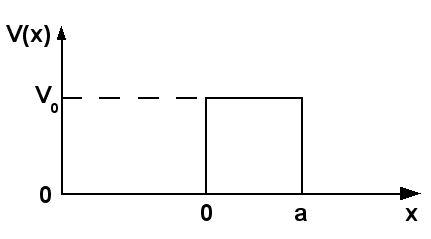 | ||
In quantum mechanics, the rectangular (or, at times, square) potential barrier is a standard one-dimensional problem that demonstrates the phenomena of wave-mechanical tunneling (also called "quantum tunneling") and wave-mechanical reflection. The problem consists of solving the one-dimensional time-independent Schrödinger equation for a particle encountering a rectangular potential energy barrier. It is usually assumed, as here, that a free particle impinges on the barrier from the left.
Contents
Although a particle hypothetically behaving as a point mass would be reflected, a particle actually behaving as a matter wave has a finite probability that it will penetrate the barrier and continue its travel as a wave on the other side. In classical wave-physics, this effect is known as evanescent wave coupling. The likelihood that the particle will pass through the barrier is given by the transmission coefficient, whereas the likelihood that it is reflected is given by the reflection coefficient. Schrödinger's wave-equation allows these coefficients to be calculated.
Calculation
The time-independent Schrödinger equation for the wave function
where
is the barrier potential with height
is the Heaviside step function.
The barrier is positioned between
The barrier divides the space in three parts (
where the wave numbers are related to the energy via
The index r/l on the coefficients A and B denotes the direction of the velocity vector. Note that, if the energy of the particle is below the barrier height,
The coefficients
Inserting the wave functions, the boundary conditions give the following restrictions on the coefficients
E = V0
If the energy equals the barrier height, the solutions of the Schrödinger equation in the barrier region are not exponentials anymore but linear functions of the space coordinate
The complete solution of the Schrödinger equation is found in the same way as above by matching wave functions and their derivatives at
Transmission and reflection
At this point, it is instructive to compare the situation to the classical case. In both cases, the particle behaves as a free particle outside of the barrier region. A classical particle with energy
To study the quantum case, consider the following situation: a particle incident on the barrier from the left side (
To find the amplitudes for reflection and transmission for incidence from the left, we put in the above equations
The result is:
Due to the mirror symmetry of the model, the amplitudes for incidence from the right are the same as those from the left. Note that these expressions hold for any energy
E < V0
The surprising result is that for energies less than the barrier height,
for the particle to be transmitted through the barrier, with
E > V0
In this case
where
Equally surprising is that for energies larger than the barrier height,
This reflection probability is in fact oscillating with
E = V0
The transmission probability at
Remarks and applications
The calculation presented above may at first seem unrealistic and hardly useful. However it has proved to be a suitable model for a variety of real-life systems. One such example are interfaces between two conducting materials. In the bulk of the materials, the motion of the electrons is quasi-free and can be described by the kinetic term in the above Hamiltonian with an effective mass
The operation of a scanning tunneling microscope (STM) relies on this tunneling effect. In that case, the barrier is due to the gap between the tip of the STM and the underlying object. Since the tunnel current depends exponentially on the barrier width, this device is extremely sensitive to height variations on the examined sample.
The above model is one-dimensional, while space is three-dimensional. One should solve the Schrödinger equation in three dimensions. On the other hand, many systems only change along one coordinate direction and are translationally invariant along the others; they are separable. The Schrödinger equation may then be reduced to the case considered here by an ansatz for the wave function of the type:
For another, related model of a barrier, see Delta potential barrier (QM), which can be regarded as a special case of the finite potential barrier. All results from this article immediately apply to the delta potential barrier's taking the limits
